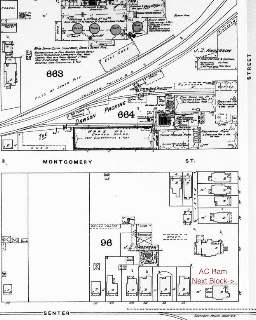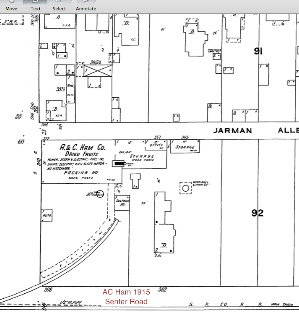 As I've been tracking down canneries and packing houses, I'll
occasionally encounter these random companies that are mentioned only
in passing with little detail about their locations. One of those
firms was A. & C. Ham, a turn-of-the-century fruit packer in San Jose.
I did a couple searches for Mister Ham, but never got any hits.
As I've been tracking down canneries and packing houses, I'll
occasionally encounter these random companies that are mentioned only
in passing with little detail about their locations. One of those
firms was A. & C. Ham, a turn-of-the-century fruit packer in San Jose.
I did a couple searches for Mister Ham, but never got any hits.
Well, it turns out Ham wasn't the owner; Ham was the product.
The company was actually Andrews and Coykendall Ham, founded in the 1870's as a pork wholesaler and packer. I don't know who Andrews was, but Coykendall was Jonathan B. Coykendall, a New York transplant and '49er who came out for the mining and returned back east, but "couldn't forget sunny California" and returned to open a meat market and wholesale meat and grocery business in San Jose. His store was at 3rd and San Fernando, but he had a warehouse and potentially packing plant at Senter and Cinnabar, along with the family house. Senter is better known today as the "Caltrain tracks north of Diridon station", but in the 1870's, it was just an unimproved street that the South Pacific Coast Railroad used as a right-of-way.


The name of the business varies: there's references to A&C Ham as one of the collection sites for the California Cured Fruit Association in 1900 (with the site listed as "west side", suggesting that the San Jose plant wasn't being used, but instead they were collecting out at the family ranch perhaps.) 1903 news articles refer to "Coykendall and Sons", while the obituary lists the "Coykendall Prune Company".
It's also hard to know when the hams stopped and the prunes began. The obituary makes it sound like one business ended and the other began, but the 1899 and 1902 city directories show the grocery store at 90 E. San Fernando, and the 1893 and 1900 city directories lists them as only in the ham business, even though we've got evidence they were doing fruit in 1900. A Silicon Valley history notes that the original ham packing plant burned in 1903, and I'd like to assume the burning of the packing house doomed the meat business, but I haven't found a record of that fire or any comments about what business was being done in the plant at that time. UCSC's archives also show that one of the grocery business's customers was F.A. Hihn, who bought supplies as well as bacon and ham for his sawmill workers at Laurel, suggesting they were still in the meat business in 1903. Their warehouse on the narrow gauge must've made it easy for them to deliver.
But they were doing mighty good, whatever they were selling. I combed through the San Jose Evening News for 1903 looking for mention of a packing house fire, but only found mention of their success in the prune business. The September 17, 1903 San Jose Evening News reported that Coykendall & Sons was in the process of packing a hundred tons of prunes, already sold in Antwerp, and had shipped 225 tons of prunes to France that year already.
Another article in the same issue also reports how being a fruit drier wasn't always a safe occupation, as the local newsies reported on "Armed Men Guard A Fruit Dryer":
Excited orchardists who want pay for prunes sold to Costa Brothers.
There is a lot of prunes at what is known as the Costa drier on the Almaden Road, about three miles south of the city, that are being guarded by armed men. It appears that Louis and George Costa bought prunes from a number of orchardists in the section referred to. They then sold them to Coykendall & Sons, packers of prunes. The Costa Brothers received an advance of $5,000 on the prunes, and the latter were taken possession of by the Coykendalls. The new owners engaged in finishing the drying of the prunes. Then the parties that had sold the prunes to the Costas came around and demanded that they be paid for the prunes, asserting that the Costas had not paid in full for the fruit.”
Jonathan died in February 1904, with a nice obituary in the February 8, 1904 Evening News. The cause of death: injuries received when his horse was spooked by a steam roller and managed to overturn his carriage (November 18, 1903 Evening News). Leafing through old newspapers, it seemed like there was a constant stream of injuries and deaths from runaway and spooked horses back in turn-of-the-century San Jose.
Frank and Horatio must've kept the business going, for the company was still visible with the Cinnabar Street plant til 1917. The obituary had mentioned that the company's sales connections in Europe was one of its strengths.

The California Fruit News, in contrast, reported on their planned rebirth. Frank and H.G. noted that they'd gotten lucky; they'd just bought new machinery from the the recently bankrupt California Cured Fruit Exchange in Emeryville, but hadn't yet moved it to the Cinnabar plant when the fire struck. Very little fruit was burned, and the family house next door was saved. However, the materials for shipping - the cotton and jute sacks (for those two hundred pound bags of fruit sent to Europe) and boxes and labels went up in flames. The Coykendall brothers promised to rebuild, and everything suggested that A. & C. Ham would continue to exist for a long time.
But it wasn't to be. A. & C. Ham disappeared, not because of business problems but because of business success. Frank Coykendall was one of the organizers and the first general manager for the California Prune and Apricot Growers (Sunsweet). The July 27, 1918 California Fruit News remarks that because of the conflict of interest, A. & C. Ham would stop packing, and the California Prune and Apricot Growers were eager to buy their modern packing house, built on the ashes of the turn of the century plant. A. & C. Ham, along the Santa Cruz branch and eventually on the SP mainline, became Sunsweet's Plant #11.
Frank Coykendall led the California Prune and Apricot Growers from its founding in 1917 through 1923, when he was forced out in a public and very messy battle that I'm still not sure I understand, even after reading the chapter in The Sunsweet Story a few times. But I get the feeling he was one of those guys who would take charge and do whatever was needed, whether the rest of the world wanted his help or not. San Jose historian, Ralph Rambo, described Frank as "quite a prominent citizen and well known for his excitable nature", and took it upon himself after the Great Earthquake of 1906 to put up posters declaring looting to be a hanging offense:
WARNINGFrank was probably the right guy for starting the association, but might not have been the best fit when the political battles started after the horrible years of 1920 and 1921.
NOTICE IS GIVEN THAT ANY PERSON FOUND PILFERING, STEALING, ROBBING OR COMMITTING ANY ACT OF LAWLESS VIOLENCE WILL BE SUMMARILY HANGED!
THE VIGILANCE COMMITTEE
“It turned out that this was uncalled for. The Sheriff had appointed many deputies. We saw National Guardsmen patrolling the streets, later saw them pitching their tents in St. James Park. And yet in retrospect we salute Frank for adding this bit of civic melodrama and we must remember that looting was very serious in San Francisco."

And, of course, A. & C. Ham isn't on the Vasona Branch, so I'm not building a model of it. I'll leave it to someone else to model the packing houses and canneries along the tracks up here.
[Photo of the A. & C. Ham packing house is from The Sunsweet Story by Robert Couchman. Coykendall house and packing plant maps from the Sanborn 1891, 1915, and 1950 maps.]



Hardage Lane Andrews of Andrews & Coykendall was my great-great-uncle. He was born in 1838 in Boonville, Missouri and moved to San Jose' in the late 1860s. He was a bachelor and lived in San Jose' with his brother, David Andrews, Jr. In February, 1889, Hardage Lane Andrews committed suicide at the age of 50, thus ending his partnership with Mr. Coykendall.
ReplyDeleteHi, Kent,
ReplyDeleteThanks for the information about Hardage; I've updated the information on A&C Ham at vasonabranch.com/packing_houses to credit him with being one of the original principals of the company.
Did you hear any stories about your great-great-uncle? A history of Cooper County, Missouri mentions that he came west in 1850, I assume to search for gold.
Hi Robert--Most of the information that have been passed down to me about Hardage pertain more to his personal (not business) life, although the obituaries surrounding his death do talk about his business ventures a bit. If you have any interest in reading them, e-mail me at kenttdicus@aol.com (since I don't see a way to attach them here). I know the History of Cooper County says he moved to California in 1850 but since he would only have been 12 years old then, I think it was later that he moved from Missouri. There's a picture of him taken in Utah in 1866 and I suspect it might have been taken while on his way to California.
ReplyDeleteI lived in San Jose' for a few years and researched what I could about his demographics, going to the site of where his home stood--Stockton and Lenzen (sp?) Streets rings a bell, but I'd have to go back to verify. Needless to say, there was no trace of his home (or any other residences) in that area by then. The only possession of his known to exist today is a monogrammed silver napkin ring. I have a few pictures of him and his portrait hangs in my dining room.